#disco-descent
Note
Hi I want to thank you for the human pinkie pie art as both a fat person and a person who helps people have parties for a living. I look almost just like this minus the hair and it's really nice to see someone like me represented in art in a positive way. Thank you
AW GOSH NO PROBLEM!!!!!! This makes me so happy!!! you sound like you rock crazy style i hope you have a great day :)
199 notes
·
View notes
Text
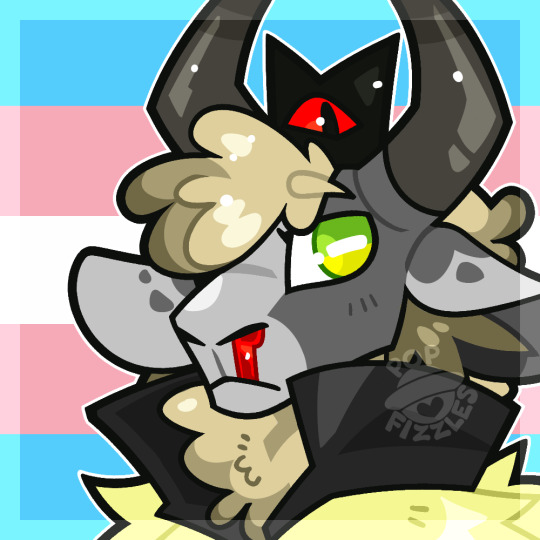
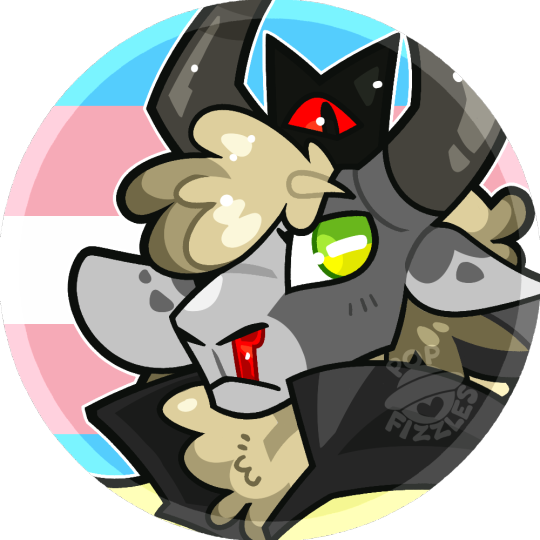
Pride Icon for @disco-descent 💗
×××
[Ko-Fi] || [Etsy] || [🏳️🌈Pride Icon Sale🏳️🌈]
#Commissions#Commission#Pride#Pride 2k23#COTL#Cult of the Lamb#COTL oc#fizzles draws#disco-descent#blood#thank you!
63 notes
·
View notes
Text

ICON COMMISSION 4 @disco-descent
#EYESTRAIN#BRIGHT COLORS#BLOOD#COMMISSION#disco-descent#CULT OF THE LAMB#NEONCORE#GLITCHCORE#DEMONCORE#ART OF THE NERD
37 notes
·
View notes
Note
trick or treat!!! :D
Here! Take one!

Yeah, that's right- yes it's a full bar! Haha it's no problem-! I just love the holiday. Have a great night! Get lots of candy!
3 notes
·
View notes
Note
OMG HAPPY BIRTHDAY!!!!!!!!!!!!!!!!!!!!!!!!!
OMG THANK YOU!!!!!!
0 notes
Text
she disco on my ‘lysium til i kim
45 notes
·
View notes
Text


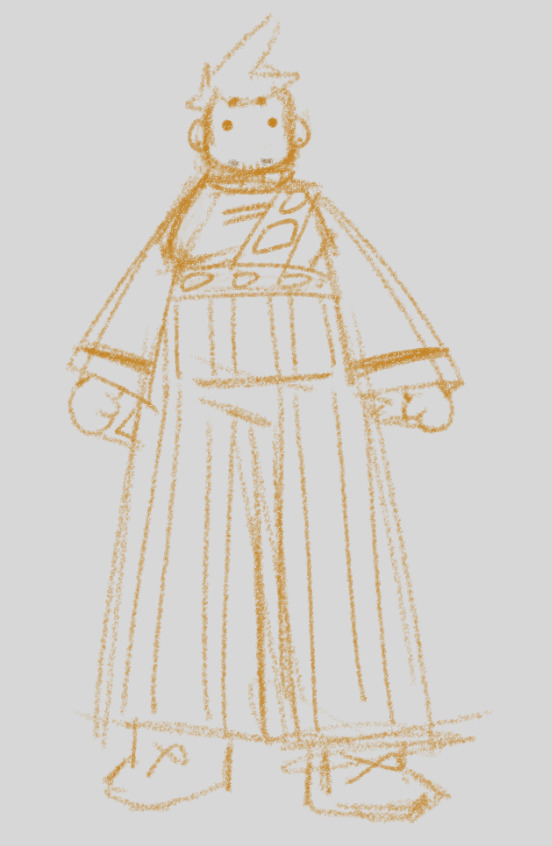


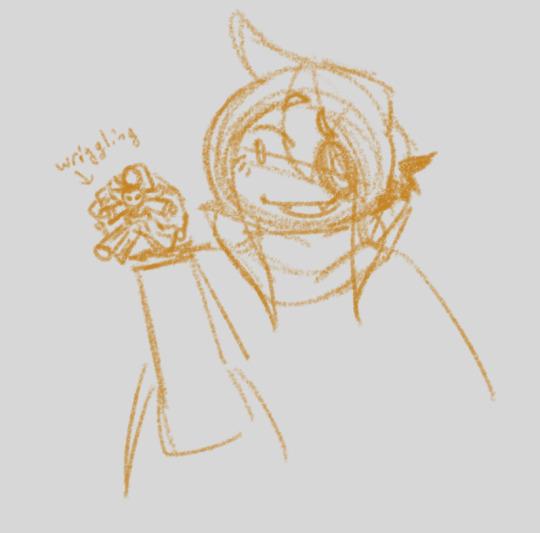
doodle dump time
#isat#ft: numerous lisas; disco-descent's freak#cut off no.3's forehead. oops#ns.tiff#not character tagging i do not feel like it. if people see this it is whatever deity's will#i should make a tag for lisa actually. as funny as calling him lisa is#dear lisa;#torn fabric / OTiF
3 notes
·
View notes
Text
there are two kims inside me (kim wexler kim kitsuragi)
#sorry youre getting to witness my descent into disco elysium in real time im just AGHHGGGH#i havent played a game in so so long... its been like. years? since i last played a new game#im having so much fun ily kim
15 notes
·
View notes
Link
There is an 89% chance you will nod your head to this song. 😈
DOWNLOAD THIS SONG:
Spotify: https://spoti.fi/3NbWr5J
iTunes: https://apple.co/3l4rF2S
Amazon: https://amzn.to/3FL4O5G
3 notes
·
View notes
Text
🤡🤡🤡!
#ooc / you speak an infinite deal of nothing#( IT'S SO REP CODED I'M GONNA PASS OUT )#( THE FAN. THE FAN!!!!! )#( ok removing myself from this account for the night bc i'm only gonna get worse ! )#( disco's a few posts down if you wanna add me for my descent into complete madness )#( this is what i get for not taking my meds all week ! Tay comes for my gd throat ! )#( OKAY OKAY I'M LEAVING GOOD NIGHT )
1 note
·
View note
Text
Some tangible Black queer history for you!
In case you needed any more proof that we've always been here - this amazing collection is courtesy of the Stonewall National Musuem and Archive!
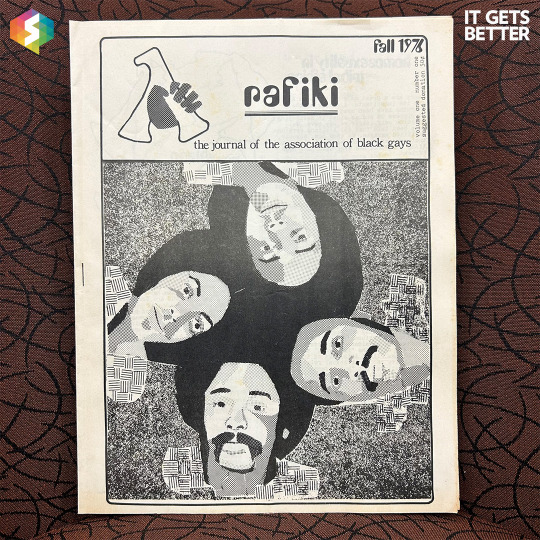
Rafiki: The Journal of the Association of Black Gays, Vol. 1 #1 (Fall 1976)
"Rafiki was a quarterly publication from the Association of Black Gays (ABG), a Los Angeles, California gay activist group that organized through education, political engagement, and grassroots activism to
improve the conditions for Los Angeles’s Black gays and lesbians.
According to the journal, the title Rafiki was chosen because it means “friend” in Swahili and “that’s what [ABG] hope to be for you.” This first issue includes an article on the history of ABG and the fact that Black gays and lesbians have been largely excluded from the political, social, and economic advances of the gay community.
Included in this issue are articles such as “Homosexuality in Tribal Africa” and “Disco Discontent” (an open letter to the owner of Studio One, Scott Forbes), as well as poetry by Steven Corbin and Frances Andrews, and book reviews. It even contains an ad for the famous Catch One Club owned by Jewel Williams, which is still
operating today!"

I Am Your Sister: Black Women Organizing Across Sexualities by Audre Lorde (Kitchen Table: Women of Color Press, 1985; from the Freedom Organizing Series)
You can read this one here!
"This small twelve-page publication derives from a speech Audre Lorde gave at the Women’s Center of Medgar Evers College in New York City regarding the exclusion of Lesbians in the feminist movement and how Lorde’s identity as both a Black woman and lesbian are inextricably linked.
Primarily, heterosexism and homophobia are major issues Lorde states are “two grave barriers to organizing among Black women.” Lorde ends the essay with the statement: “I am a Black Lesbian, and I am your sister.”
Her emphasis on the duality of this identity stems from a 1960s poster that said “He’s not black, he’s my brother!,” which Lorde states infuriated her because “it implied that the two were mutually
exclusive.”
Kitchen Table: Women of Color Press was founded by Barbara Smith—another Black Lesbian feminist—and Audre Lorde in 1980 to create a publishing apparatus for women of color who at the time did not have control over how they were published except through the white-dominated outlets."

Flawless! The Life & Times of T.B.D.J. AKA Tiffani Inc. AKA Mrs. … (Manuscript) by Tiffany Bowerman (July 2007, A&E Publishers)
This autobiographical manuscript traces the life of Tiffany Bowerman aka Tiffany B.D. Johnson (b. 1959), who states that she “was the first African-American Transsexual to have state issued birth certificate reissued [1990]… was the first to legally marry three different active duty military men… [and] first… to found their own Christian Denomination… The Agape-Ecumenical Christian Denomination.”
Further, she states “I have tried to put together something striking and original[,] a journey from childhood to self aware adult. A life that was and is with all regrets included.”
This manuscript is a preliminary copy of a rough draft, and contains various memoirs, photographs, legal documents, and ephemera.
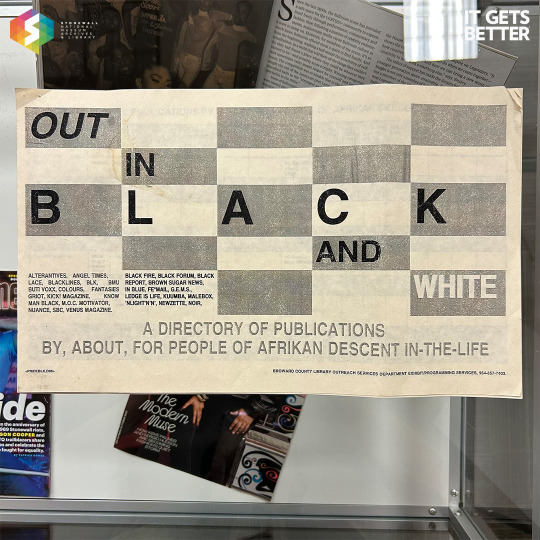
Out in Black and White: A Directory of Publications By, About, For People of Afrikan Descent In-The-Life by the Broward County Library Outreach Services Department Exhibit/Programming Services with direction by Eric Jon Rawlins (January, 1996)
Out in Black and White is a directory of various serial publications (magazines, newsletters, journals, etc.) throughout the United States that are focused on the Black LGBTQ experience. According to the directory, “[t]his project was inspired by the atmosphere of strength, oneness and productivity created by the Million Man March [on October 16,] 1995.”
The Million Man March was a political demonstration that took place at the National Mall in Washington, D.C. with the purpose of encouraging involvement in the improvement of the conditions of African Americans. Eric Jon Rawlins was a Broward County, Florida librarian who at one time was also the second vice president of the NAACP Fort Lauderdale branch in the late 1980s.
Currently, the Eric Jon Rawlins Collection consisting of personal and professional papers, as well as his 6,000 vinyl record album collection, are housed at the African American Research Library and Cultural Center Special Collections in Broward County, FL.
#it gets better#black history month#bhm#black trans lives matter#lgbtqia#queer history#lgbtq history#black history#queer archive#queer lit#studyblr
103 notes
·
View notes
Photo






Here are the Ko-Fis I did today! Thanks everyone for hanging out, even if I wound up cutting stream a bit earlier than usual.
@disco-descent @toxicglitch @justalitlecreacher @thebrutishcutesy @valentinesdayy
#fizzles draws#disco-descent#toxicglitch#justalitlecreacher#thebrutishcutesy#valentinesdayy#MLP#MLP:FiM#thank you!!
117 notes
·
View notes
Text
Black Mirror’s Demon 79 and the Justification of Brown Feminine Rage (warning: spoilers)

What if intrusive thoughts can be valid, and it is okay, maybe even necessary to act on them sometimes? If violence isn’t the answer, why must it so often be the question?
Set in Northern England, 1979, “Demon 79″ is the final episode of Black Mirror’s sixth season. It follows Nida, a meek sales assistant with a mousy appearance, who is tasked with the most complicated and important mission: to save the world by taking the lives of three human sacrifices in the days leading up to May Day.
Champions of the extended metaphor, Black Mirror employ the talents of Anjana Vasan (an Indian-born, Singaporean-raised, and U.K.-based actress) who plays Nida Huq and Paapa Essiedu (an English actor of Ghanaian descent) who plays Gaap*, the demon Nida accidentally invokes upon finding a talisman that begins this stressful mission of her. Gaap, devilishly handsome and charming, trying to earn his “wings” and be initiated into demonhood reassures the panicking Nida that she is not going mad, she is not a bad person, and the people she is encouraged to kill are vetted through his soul-reading as deserving of death.
*Gaap is considered through stories of demonology and texts related to the Testament of Solomon to be the Prince of Hell, with angels as siblings and a penchant for manipulating women and rendering them infertile.

Gaap adjusts his form to something more comfortable for Nida by changing into a look-a-like of Bobby Farrell from the famous disco-funk German-Caribbean vocal group known as Boney M. Having the representation of a demonic entity be a Black man while allowing him to manifest into a symbol of appeal for Nida turns the inherent vilification of Black men on its head without contributing to the hypersexualization of Black bodies. Gaap is never presented as a love interest for her, but viewers do get to see them develop a snarky back-and-forth. I almost never see Black and brown leads banter like this.
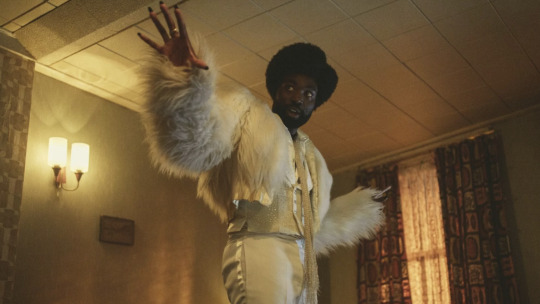
Another reason I’m glad Gaap was not portrayed as a sinful symbol of sexual desire is because Indian women already have to navigate a shame-fueled purity culture, and I wouldn’t want to see her grapple with her feelings for someone who is not only outside of her race and religion, but isn’t human. Writers avoided the idea that to love Gaap was to love something forbidden in all possible ways. And we don’t need to see Black folks depicted as not-human. The history of both American cinema and politics has acted on that dangerous perception already.
When I saw the opening scene of Nida with her wide eyes waking up to get ready for work, I recognized the doe-like innocence in her face as the one I have been raised to emulate. She looks so much like my mother 30 years ago. Minimal makeup, modest clothes, hair neat and tied back.
Moments of Nida’s inner demons being unleashed start off as fantasies she has. She is quietly scurrying through her life as an oppressed minority in 1970′s England, where xenophobia and racism showed up everywhere, from the actions of the British Nationalists to the microaggressions Nida faces at work for simply bringing her potent biryanis to the stock room and “stinking up the place”.
Indian women are some of the least visible in politics historically and presently because we are raised to not make a fuss of things, to be quiet and reserved and let white people act how they want towards us because we are guests in their countries, even when they’ve colonized and pillaged our own. I feel Nida’s pain as she thanks the white people around her for the bare minimum (allowing her an alternative place to eat, such as the basement - where she finds the talisman that changes her life) and avoids the confrontation and rage within her, even sighing in defeat at the NF* tag that has been spray-painted on her front door.
*NF stands for the National Front, a far-right, fascist political party in the United Kingdom, founded in 1967.
I crave catharsis for Nida. And for her late mother, whom she has a photo of in her apartment. She explains after the first sacrifice that her mother was perceived as crazy, and now Nida is afraid that people will think the same of her, and this time, because of what she’s done, it will be true. I wondered if Nida’s mom was called crazy because she had stood up for herself, reported abuse or harassment that was occurring within the Indian community itself or in her own home, or tried to leave Nida’s father. None of these scenarios would make the show seem like fiction at all, at least not for many of the South Asian women trapped by the chains of patriarchal ideals.
There are moments where I am concerned Nida is enamored by Michael Smart, a white politician giving a campaign speech outside the store she works at, as if his mere acknowledgment of her existence without visible disgust is enough to make her heart flutter. Again, I enjoy seeing a Black and brown lead in this episode, and knowing that other viewers are getting to see the many instances of white culture that exposes the racist ignorance and unfair power structures that exist in western society, workplaces, and even the homes of white folks themselves. (I was so happy for little Laura to hear of what was done to her assailant).
When it comes to stopping the world from absolute destruction in a nuclear holocaust, the heroes have never really been people who look like Nida. (It is worth noting that the head writer for this episode was Bisha K. Ali, who also is the executive writer for Disney+’s Ms. Marvel and has tackled many of the same representation issues in her work). People like her don’t have the permission to be loud, angry, or violent without consequences, no matter how justified. Meanwhile, with unchecked authority, bombs go off and innocent people die and children cower in their beds and white men get to act on their worst traits and impulses, however sinful, with little to no accountability.
Even when Nida is being violent, it is for the greater good. Because it has to be. Even female rage has to serve a purpose for others. It cannot just be hers. If she’s going to be angry, she better be trying to solve crime or save the world.
And through this most guttural and sometimes poisonous part of being a human, Gaap sees her. Maybe it’s because he has transformed in the image of Nida’s celebrity crush or maybe it’s truly the way in which he interacts with her, Gaap sees Nida. He recognizes the type of violence she would and would not indulge in. He tells her she should feel more at ease after killing the first sacrifice, a pedophile she clobbers with a brick before he falls into a river. He continuously recognizes her hesitation, and suggests “Dutch courage”, or booze before following through with the second kill. It is inappropriate in Indian culture for women to drink, which Nida notes when she tells Gaap she doesn’t. Then he asks her if she wants to, something, from the expression on Nida’s face, it doesn’t seem like she has ever been asked.
Upon entering a pub full of (yes, all white) men, Nida is dismissed by the (also white) female bartender who looks just as irritated by her existence as her coworker Vicky, who had reported how unfair it was that she had to smell Nida’s lunches and endure the lingering scent at work. An older (also white) bartender (who might be the owner) takes her order with the same polite and quiet discomfort of her boss, who had presented her with the basement lunch “solution” to appease Vicky. It’s subtle but the approaches in which different age groups and genders of white English folk take with engaging with Nida demonstrate the variety of ways in which people of colour experience discrimination. At its worst, it is violent hate crimes and unjust legislation that mutates into full blown genocide. At its mildest, it’s passive aggression and strained tolerance.

It’s more apparent with the second killing (of a man named Keith who killed his wife) that Nida does have the option to be as righteous as she wants to be, which is something I really appreciated about her character. Even if she was killing to prevent the literal apocalypse, and the clock was 6 minutes from midnight -- she must follow the cadence of at least one kill a day -- the moment she has to hear Keith’s justification for what he did and his attempt at absolving himself with the statement “I’m not a bad husband, but --” she swings a hammer at his head to shut him up. She then bashes his head in repeatedly, even to the point where Gaap is wincing at the sight. If this was just about killing people to stop a bigger disaster and loss of life, she wouldn’t be losing herself in the act like she did.
The third and final kill occurred in the next few minutes, as Keith’s roommate, witnesses her trying to exit, which presents itself as problem in allowing her to continue with the mission if she’s arrested. It’s messy because it was fast, the least premeditated, and she doesn’t know who the man is or if he’d done anything as bad as the previous two skills. Because of this, she’s much more apologetic as the man dies, later finding out from Gaap he was Keith’s brother, Chris, an “ordinary” person who would not have been one of Nida’s choices.
But as Gaap says, “What’s done is done”. And the three lines on the talisman should have disappeared indicating that Nida has fulfilled her duty. But it still has a line remaining, so a confused Gaap dials 666 (of course) on Nida’s rotary phone to explain the issue to his superiors. He tells Nida that Keith apparently didn’t count because he’s a murderer and anyone who’s been directly responsible for the death of another human being (not counting future deaths they might be responsible for) is off limits. Chris counted because his death still occurred just before midnight.
Nida doesn’t snap psychologically and decide she enjoys this and is going to become a serial killer, which is a direction I find common in other Black Mirror episodes, where the white and/or male character loses it and/or goes on a killing spree. She grapples once more with her initial unwillingness to participate in this because even when given the go-ahead and to have the most reason to, she enters a mental boxing ring with her instinct v. culture v. morals. From my own experience and what I have seen in my own community, outward expression of rage is never the first emotion a woman reaches for...because she can’t always afford to in the way others can.
“My whole life, I never wished harm on anyone.”
Gaap tells her what’s at risk for him, and he describes a fate of punishment that she says sounds like her life now. She stands, empathizing with an actual demon, and deciding to continue with the mission. Gaap also reminds her this isn’t solely for him; she possessed a darkness within her that drew her to the talisman. So, he asks her, who pissed her off?
To Possette’s Shoes they go.
Vicky, a prime choice for the grand finale, delegates the task of attending to the young girl Laura (from earlier) and her mother to Nida. Because the little girl creeps Vicky out. Gaap informs Nida that because she killed Laura’s dad, Laura doesn’t kill herself at 28 and instead goes to therapy, becomes a mother at 29, and a grandmother at 57. It’s a comforting thought amidst the mayhem of it all.
Michael Smart makes an appearance once more, as his father and the boss’s father, are old college friends, and Nida’s boss had promised him a suit and shoes on the house. The boss unsurprisingly selects Vicky as the sales attendant, with Gaap grumbling to himself as Nida’s eyes go from ‘excited crush’ to just crushed. Her boss then chooses to notice the boxes on the floor from when Vicky could’ve been cleaning up and hisses at Nida, “Could you pick up the bloody mess?” This prompts Gaap to suggest the boss be the next to go.
Nida moves on to cleaning up the boxes, eavesdropping on the conversation between Michael and Vicky. When Michael says he hopes he has her vote, she says she is siding with the National Front who she believes will help rid the town of all the pesky foreigners. And then Michael Smart reveals himself to be what a lot of politicians are: covert bigots. He explains to Vicky that an explicitly xenophobic campaign would be too polarizing, so you have to elect a moderate who can win over the masses and put the evil plans in motion. (Sound familiar?)
There is a subliminal language spoken among white supremacists, even if they smile politely at people who look like me and Nida. And this revelation that she witnesses presents an even more justifiable option for Nida’s third kill.
She asks Gaap to give her information about Michael’s future, which he hesitantly reveals to her. Michael Smart wins the election, eventually becomes prime minister, and leads a new world order built on white supremacy. Nida decides he is the final target, but Gaap tells her he wouldn’t be the right choice because the Satanic world he comes from is a fan of his work and everyone there would want Michael to be able to facilitate the upcoming deaths that occur as a result of him first winning the election to become a member of Parliament.
But Nida is set on him, or no one, giving Gaap the ultimatum to get on board or risk his own banishment after failing his initiation.
Meanwhile, a police investigation occurs which leads to the bar staff identifying Nida as a “muttering Indian woman” who was at the bar the night Keith died. Len Fisher of Tipley Police arrives at Nida’s apartment, as part of routine questioning, and she invites him in, with Gaap’s suggestion to kill him.
Fisher is the first white person to speak to her as person, too, even though he’s there on the premise of Nida being a potential suspect. Maybe this is more covert trust-building behaviour, maybe as a cop, maybe as someone generally suspicious of people of colour. He is the most mild-mannered, middle-man in the whole story.
Fisher follows Nida who follows Smart after his speech at town hall. This is where I’m a little surprised but not displeased. The other episodes end with something sad, violent, and/or redemptive. Nida gets a bit of everything, but as with all things Black Mirror, not in the way you’d expect. In society, Nida may be reduced to a mad woman telling an insensible story, enduring the same perception people had of her mother. But society doesn’t last long, and she walks off into a kind of nuclear, fiery sunset with a new friend.
The deadline for the sacrifices had been May Day, also known as Workers’ Day or International Workers’ Day to commemorate the struggles and gains made by workers and the labour movement. Nida, representing intersectional identities of the working class (immigrants, women, people of colour), was not listened to or believed, and the world ended because of it. Her weapon of choice had been a hammer, a tool meant for building that was used for destructive but necessary purposes. This could be a reference to the Communist party’s symbol of a hammer and sickle, which represents proletarian solidarity. The meaning of the episode, particularly its ending, captures the significance of the working class and how our world relies on them to function and last. When their efforts are stunted, their sacrifices are in vain, or they are not heard, the world ends.
#black mirror#demon 79#tv series review#black mirror season 6#paapa essiedu#digital illustration#fanart#commissions open#anjana vasan
272 notes
·
View notes
Text
Sonic Character Cultural Coding
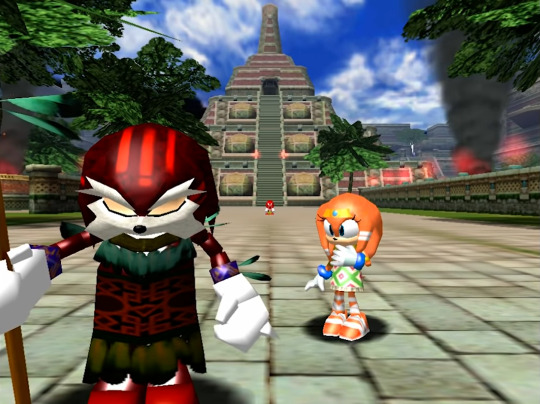
Despite the fact that a good chunk of Sonic characters are anthropomorphized animals, a large amount of them have been given explicit or implicit coding that aligns with cultures that we see on Earth! I’ve found it hard to find a detailed list of it all online, so... I made one!
Disclaimers:
I am going to say: some of these may seem pretty obvious, but at the same time I’ve seen people miss them, so I’ll be including both the “obvious” and “obscure” coding.
If I accidentally said anything offensive, please let me know so I can correct it!
We are going to start with Sonic himself, and then do the rest in alphabetical order! Let’s go!
Sonic the Hedgehog (+bio fam) – Egyptian
We’re gonna start with Sonic the Hedgehog himself– who is very much coded as Black, specifically of Egyptian descent.
In Adventures of Sonic the Hedgehog 1x50, “Robotnik’s Pyramid Scheme,” Robotnik goes back in time to try and prevent Sonic from ever existing by keeping his ancestors from meeting. Sonic goes back in time to stop him and we meet Masonic and Penelope who are Sonic’s great-great+ grandparents and live in ancient Egypt. Masonic is specifically designed to look almost exactly like Sonic.

Later in the episode they end up inside a pyramid and meet yet another ancestor of theirs, who is an enchanted mummy hedgehog. He gives Sonic a chaos emerald to kick Robotnik’s ass. He also looks exactly like Sonic.
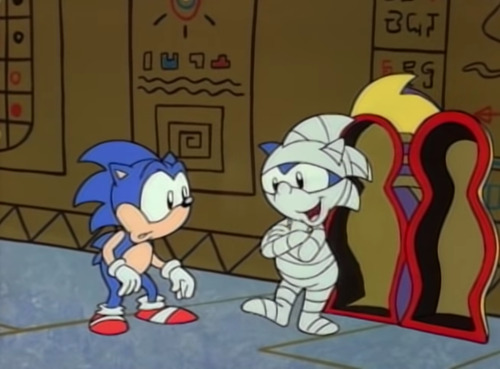
And SPEAKING OF enchanted mummy hedgehogs! In the Sonic Underground episode 1x22, “Mummy Dearest,” Sonic is AGAIN explicitly given ancient egyptian ancestry, when he and his siblings find a book talking about their family history. They use the book to find directions to a magic scroll which is protected by one of their ancestors, Aman-Rapi, who is again very clearly from Ancient Egypt and looks like Sonic.

In this pic, they can be seen posing in front of a wall containing heiroglyphs, with a mummy behind them, Amon-Rapi is literally dressed as a pharaoh wearing a variation on a Khepresh, his name is obviously a play on Amun-Ra… yeah, they’re Egyptian. So, in two different adaptations Sonic has been given explicit African ancestry.
@ifirestone also pointed out to me that Sonic Adventure 2 has a lot of hedgehogs all over the pyramid locations, and @nonbinarycharmybee pointed out that his shoes are based off of Michael Jackson’s shoes in the music video for “Bad;” Jackson is a very celebrated African-American musician. And @killer-squirtle pointed out that his design is most likely based on an African Pygmy Hedgehog, which live in “west, central and east Africa.”
Then in Sonic the Hedgehog 2 (2022), there’s a scene where Sonic messes with his quillstyle and is seen experimenting with different styles. Before he settles on the mohawk (very much resembling his AoSTH-SatAM style), he tries out what looks like a Flat Top haircut and Natural Afro; in the latter, he specifically strikes a pose very reminiscent of the 60s Disco Era, which was suuuper associated with African-Americans.
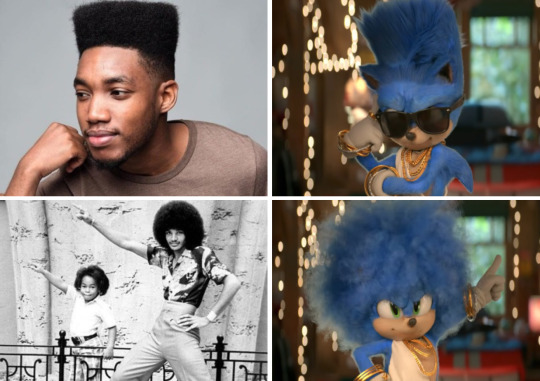
Finally (so far), Sonic’s first english voice actor was Jaleel White for the first three television shows, who is Black; he set the standard for english!Sonic’s voice and what he should sound like. Sonic’s newest VA for Sonic Prime, Devon Mack, is also Black!
Edit 07/15/2022: @birdsareblooming noticed that in Sonic and the Secret Rings, Sonic is reading the Arabian Nights in Arabic, which is the official language of Egypt as well as several other African and Southwest Asian countries!

As we’ve established Sonic is Egyptian, I think we can also safely assume that his bio fam is as well– Sonia and Manic were in that Underground episode after all, and as Underground doesn’t seem to give them a father I think we can safely assume that the royal lineage is through Aleena. Metal Sonic is a robot but as he’s supposed to be near identical to Sonic, I think we can put Metal under the same coding (no pun intended).
Antoine Depardieu/D’Coolette the Coyote – French

Antoine is very very obviously coded as French, first in the SatAM television show he debuted in and then in the Archie comics. His original surname, Depardieu, is a French surname– I don’t believe D’Coolette is a real surname but it is supposed to sound French with the “d’[x]” structure.
Antoine speaks in an exaggerated French accent, which is spelled phonetically in the comics so that it can still come across. He often (at least in SatAM– I’m not as knowledgeable on Archie canon) needs help understanding English words and asks for translations or butchers pronunciation. He also uses the French phrases “qui” and “sacre bleu.” Unfortunately, in SatAM he also falls into the French Coward Stereotype, which seems to have begun in the 40s and shot into prominence in the United States in the early 2000s.
Babylon Rogues (Jet/Wave/Storm) – Iraqi
The Babylon Rogues are ABSOLUTELY Iraqi. How do we know this? They are literally called the Babylon Rogues.
In case u didn't know, Babylon was an ancient empire that was p powerful in the BC years. Its capitol town– named, you know, Babylon– was an independent city-state and for a while the largest city in the world. They also had one of the seven wonders of the world, the Hanging Gardens of Babylon The city of Babylon, whose remains are now a world heritage site, is now what is currently Hillah, Babil Governorate, Iraq.

The Babylon Rogues are clearly named after the Babylonian empire. Their home base is also literally named the Babylon Garden, a reference to the Hanging Gardens. I’m not super knowledgeable on architecture, but the design of the Garden seems to be similar to the Umayyad or Abbasid architectural movements of Iraq.

This all very much codes the Rogues as being descendants of the Babylonian empire, ie: Iraqi.
Bark the Polar Bear – Russian

This is gonna be one of the shorter ones, but a 1996 interview with Hiroshi Kataoka, head of SEGA AM2, says that Bark is “a Polar Bear who lives in Russia.”
I don’t believe Bark is given any specific Russian coding following that, but it should be noted that that was the original intention.
Blaze the Cat – Southern Asian
Blaze’s concept designs can be pretty South Asian-coded first off; in the middle bottom row in the pic above, you can see her wearing Shalwar, (maybe shalwar kameez? it's hard to tell what kinda top she has) which is a popular Southern and Central Asian fashion.

Her final design includes a straight-up bindi– listed as such on the Sonic wiki. Bindi are a mark on the forehead worn by women in Hinduism, Buddhism and Jainism, and occasionally Islam (notably in Pakistan during Eid). While obviously anyone of any race can be of any religion, as the bindi originated in Southern Asia, it’s highly associated with that area and is worn by, well, a crapton of people in South and Southeast Asia, for both cultural and religious reasons.
Also, her kingdom: we don’t see it much in the games (in Rush Adventure, they’re mostly traveling through outlying islands and ruins), but we do see it in the IDW comics.

It seems very inspired by Mughal architecture, an Indo-Islamic style developed from Indian, Islamic, Iranian and Central Asian traditions.
In the mobile game Sonic Forces: Speed Battle, Blaze is given a costume for Lunar New Year, as is Silver (see Elise’s section for more Silver info). Lunar New Year is associated mainly with China, but is celebrated in several other Asian countries, including Indonesia, Japan, Malaysia, the Philippines, Singapore, South Korea, Thailand, and Vietnam.

We also got THIS tweet from the official Sonic account in November 2020, showing her having tea in her palace. @penosh-wom pointed out to me that the patterns in the room are “VERY reminiscent of India,” and that the scenery outside looks very much like the Asian coast.

The caption is in Japanese, but translating it to English shows that the descriptive is literally “Indian summer with calm waves.” An Indian summer is a term for unusually long hot weather in autumn, but like. Come on.
With that, I would say Blaze is most likely Indian, though the coding is a little vague. She is at the very least Asian, likely South or Southeast.
Bunnie Rabbot – Southern American

Bunnie seems to be coded as coming from the Southern United States (or at least the Mobius equivalent); she has a Southern US accent, for instance, and similar to Antoine in written media it is spelled phonetically so that it continues to come across; using “ah” instead of “I,” often cutting off the “g” in words ending in “-ing,” etc. Many of her sayings– such as “oh my stars”– are distinctly Southern US as well. This was all established in her SatAM appearances and continued into the Archie comics.
Should be noted that also, very unfortunately, one early Archie comic had her say several things to reference support for the Confederacy as a way of tying into her Southern heritage. Thankfully, as far as I’m aware this has only appeared in this issue and has never occurred again.
Princess Elise (+Soleanna, possibly Silver) – Italian

Soleanna as a country is incredibly inspired by the city of Venice, Italy, to the point where Silver’s original name was Venice. The city is known for being built on 118 small islands connected by canals and bridges, with it often being called the “floating city.”
The amount of canals and bridges in Soleanna is definitely an intentional reference, as well as the very Venetian Architecture of the buildings.
Now, Silver– While it’s unclear if Silver is from his timeline’s Soleanna, he does have a bit of Italian coding as well!

Firstly, his original design was literally named Venice. (design in the pic, bottom left.) And there’s one other little detail– in Sonic and the Black Knight, when you play as Silver (Sir Galahad), his sword looks a LOT like a Cinquedea– an Italian dagger.
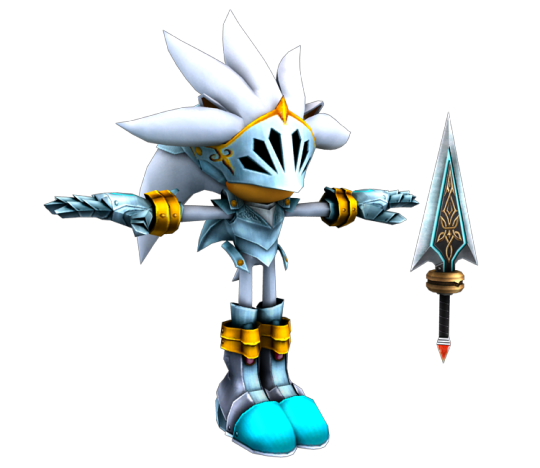
Silver being Italian is a bit less certain than the rest of Soleanna, though– the original name and dagger are the only implications and he hasn’t had much since. In Sonic Forces: Speed Battle he is given a Lunar New Year outfit, which could imply he is of Asian descent (see: Blaze); of course he could be mixed, or simply celebrating with Blaze (who also had a Lunar New Year outfit release at the same time). So while Silver isn’t certain, I will say the inclusion of the Cinquedea interested me enough to note him here.
Espio the Chameleon – Japanese
Espio is definitely coded as Japanese throughout his appearances. Firstly, and most obviously, his special interest in being a Ninja; ninjas were mercenaries or covert agents in feudal Japan, incredibly skilled in martial arts and ninjutsu, and they were often used as spies or bodyguards. Japanese legend would also often associate the ninja with invisibility, a major part of Espio’s powerset. Espio’s favor for the shuriken stars as a weapon also tie into this, as well as the fact that in the Japanese script he uses the old-fashioned formal pronouns “ware” and “onushi.”
That’s not all, though, of course: Espio has been stated in the Sonic City character profiles to be “a lover of traditional ways,” specifically referencing his ability to play the shamisen, a traditional Japanese instrument. He is seen playing this instrument in the Chaotix’s Sonic Heroes Team Blast.

@nonbinarycharmybee also pointed out that in THIS official artwork from Sonic Channel in 2021, Espio is seen writing with an ink brush used in Japanese calligraphy.
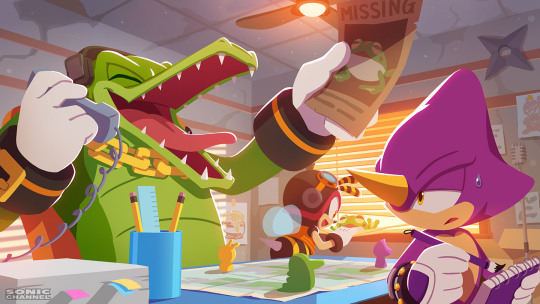
Gold the Tenrec – Indian
Gold is specifically stated by creator Evan Stanley to be from “whatever the Sonic World equivalent” of India is. This is shown in her design as well: her outfit consists of a brown sari, which is a very popular and traditional style in India, as well as nearby Southern Asian countries.
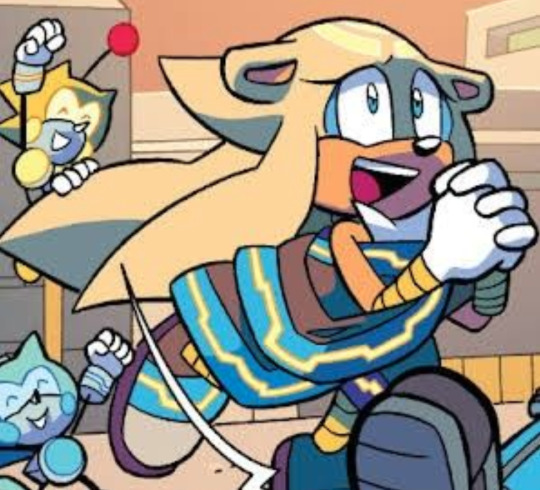
Knuckles the Echidna (+Clan) – Jamaican + Mesoamerican
Oooh Knuckles is interesting, strap in everyone!

According to Sonic Advance 2: Prima's Official Strategy Guide, Knuckles was originally intended to speak with a Jamaican accent. As well as this, the green/yellow/red color scheme of his shoes was intended to reference the Rastafari flag, Rastafarianism being a religion developed in Jamaica. This heritage can also be seen reflected in his dreadlocks– his quill-style is referred to as such in many canon places. In real life, dreadlocks are a Black hairstyle; the 2011 official census of Jamaica listed 92.1% of the population as Black, and dreadlocks are often associated with the Rastafari movement, as Rastas regard them as a symbol of strength and it emerged as a traditional religious style in the 1940s.
This isn’t the only coding Knuckles gets, though; he is known to be descended from the Knuckles Clan, which are heavily inspired by Mesoamerican cultures.

The Sonic Adventure team traveled through Central and South America to get inspiration for Knuckles’s clan’s culture, which can be seen in basically every aspect of the Clan lore. For instance, clothing worn by the echidnas is very similar to the traditional styles of the Aztecs and Mayas. This includes the decorative feathers seen on Pachacamac and the filmverse!Clan, as feathers were popular and prized materials in pre-colonial Mesoamerca.
Their architecture is almost identical to the step-pyramid temples of the Aztecs, Mayas and Toltecs. The same architecture and clothing style can also be seen in Sonic the Hedgehog 2 (2022), with most of the echidna warriors seen with spears, including baby Knuckles. Throwing spears were used extensively in pre-colonial Mesoamerican battles.
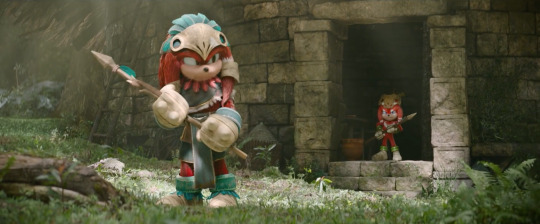
There is also a large serpent that lives near the Mystic Ruins of the Clan, likely a reference to the Aztecs’ Quetzalcoatl and the Mayas’ Kukulkan.
Also, most obviously, the names: Pachacamac is named after a Peruvian archeological site, which itself was named after the Ichma creator god Pacha Kamaq. Tikal, meanwhile, was named after the archeological ruins of a Maya city, consisting of multiple pyramids.
As a sidenote, it should be noted that Ken Penders’ echidnas in the Archie Comics were definitely supposed to be English: @thankskenpenders laid it out very well in this post, but they were written to come from “Mobius’s equivalent of England,” named after the earliest name for Great Britain, and he wrote the species to be “seafaring colonizers.” Penders did write this before the release of Sonic Adventure, but obviously after Knuckles’s initial release with Jamaican-coding, so can we call this whitewashing? I don’t know enough to speak on the subject, but with the reset of Archie comics and its later cancellation, and the games’ Knuckles Clan being represented in several other mediums (such as Sonic X, Sonic the Comic, etc.) I think we can safely say that the Mesoamerican coding is a bit more canon.
Lupe the Wolf (+pack) – Indigenous American

Lupe the Wolf first appeared in the second season of Sonic SatAM, and from her first appearance was incredibly indigenous-coded, as was her wolf pack. This coding continued through the Archie comics. This will mostly focus on the SatAM coding, as Archie pulled from that and, once again, I don’t know a ton about Archie!Canon, but SatAM is pretty damn obvious with its coding.
Lupe’s pack is described as being a native tribe to the Great Unknown region, who live in “harmony with nature.” Their land was captured and culture destroyed by the invading Robotnik, with the survivors retreating into their civilization’s ruins. In order to keep themselves safe, they set up inscriptions near their cave threatening to curse anyone who wanted to come in; Lupe later readily admits this to Sonic, Sally and Antoine, the latter of whom was scared shitless by the idea of getting cursed.
So, for starters, Indigenous American culture is, in general, built a lot upon a reverence for nature, believing that humans are not masters of nature but merely a part of it and acting accordingly. The capture of their land is obviously intended to be reminiscent of American colonization by the Europeans, which was devastating to the Native tribes, with entire cultures and languages being wiped out and Indigenous people still facing serious oppression in modern times.
Much like the Knuckles Clan, the Wolf Pack’s ruins are reminiscent of many indigenous archeological sites, such as Mesa Verde, which is also built into a cliffside. The brief glimpse we have of the Wolf Pack’s pre-colonized land also shows them living in huts reminiscent of many indigenous tribes.

The room Lupe gives exposition in also has them all sitting around a smoking fire pit; many indigenous cultures will gather around fires for meetings and discussions.
Lastly, many people (mainly white people) hold the superstition that Indigenous people have the ability to curse them; just think about how much the “this place is haunted because it was built on a Native burial ground” trope is used. The “Magical Native American” trope tends to say that Natives are magical because of their closeness with nature and “lack of civilization.” This very much falls into the Noble Savage trope, making them appear exotic or inhuman to outsiders and trivializes their connection to the natural world.
SatAM does a pretty decent job subverting this trope, with Lupe very clearly stating there is no curse and they use it to make small-minded intruders keep out; this shifts the ridiculousness of the situation onto the non-Native-coded characters.
Sonic: Ant! Forget the curse. There is no stupid curse!
Lupe: He's right, Antoine. We use the threat of a curse to keep out intruders.
Antoine: No curses? Oh. Phew and phew again. I am so happy to hear that.
- SatAM S2e10, “Cry of the Wolf”

There have been a few other instances of Indigenous-coding with Sonicverse characters, unfortunately not all of them represented as well. The inhabitants of Speedster Island in the Sonic Underground episode “Head Games” are just as indigenous-coded in their appearance, the episode very much falls into the “Native people need the outsiders to come save them” stereotype, as well as the “Native people mistake outsiders for gods” stereotype. The Gogobas in Sonic Boom are also given indigenous-coding with their chief’s headgear, village huts, and jokes made referencing the “cursed burial grounds” trope and them replacing the captured indigenous children in the parody of Indiana Jones and the Temple of Doom. The Gogobas are not exactly shown in a positive light, though to be fair, neither is anyone in the show; specifically, the Gogobas’ “tradition” is to guilt trip everyone into doing what they want.
For other indigenous coding in major characters, see Knuckles and Rotor sections.
Marine the Raccoon (+Coconut Crew) – Australian

Marine is very obviously coded as Australian; throughout all of her dialogue, she uses Australian slang, most obviously calling her friends “mate.” She also uses the exclamation “strewth,” which is used often in Australia and Aotearoa. Other slang includes “sheila” (woman), “no drama” (no worries) and “ya mug” (friendly insult, usually for a gullible person). The other koalas on her island, who raised her, also use the same language.
Marine is also given pigtails shaped like boomerangs, a tool heavily associated with Australia, specifically Aboriginal Australian hunting. Koalas are also a species that is native to Australia– I believe only Australia but I can’t be sure.
I don’t know enough about the coding of their architecture/etc to say if they’re coded as generally Australian or Aboriginal specifically, though I will say they definitely seem to be native to islands, which may imply they are of a Polynesian tribe near Australia or Aotearoa, such as Māori or Tahitian people.
Should be noted though that Marine appears to be adopted; she was raised by the Coconut Crew, who are all koalas. She does have some serious tanuki coding that may additionally code her as Japanese; for more, see Tails’s section.
Mina Mongoose – Chinese
As far as I’m aware, Mina’s Chinese-coding isn’t super explicit. However, she is seen wearing a red qipao for formal occasions, designed by Jeff Axer.
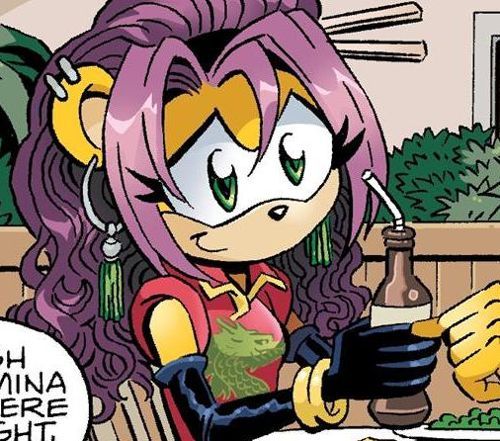
The qipao, also known as a cheongsam, is a traditional Chinese dress inspired by the Manchu people (founders of the Qing Dynasty). In modern times, the cheongsam is very popular for festivities such as weddings and holidays (especially Lunar New Year), as well as school and work uniforms.
Mina’s qipao is also specifically given a green dragon design very reminiscent of the Chinese dragon as well as many other Asian dragon species. She also is given ornamental earrings and hair pieces that are very clearly inspired by Chinese fashion.
Nocturnus Clan + Voxai Aliens – Roman/Greek
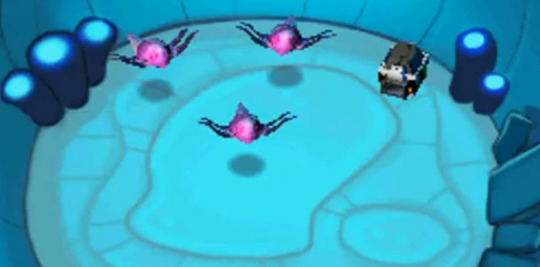
Honestly, these clans seem to have coding in name only– they both have specific cultures of their own, with the Voxai architecture specifically being based mainly on the rock and plants of their home planet, and the Nocturnus clan being very futuristic. But it is interesting to note!
The Nocturnus clan army ranks are very similar to Imperial Roman ones, with titles such as hastatus and praetorian. Ix being called the “Imperator” is also a Latin word from which the word “Emperor” is derived, and referred to an army commander. Ix’s Gizoid prefects are also named Scylla and Charyb, a reference to Scylla and Charybdis, two sea monsters in Greek mythology which appeared in the Odyssey. The historian character Nestor the Wise is named after King Nestor of Gerenia, also from the Odyssey as well as the Iliad.
The Voxai names are also derived from Greek and Roman mythology: their name likely comes from the Latin noun “vox,” which refers to a voice and would reference the aliens’ telepathic powers. Most of the named Voxai are given Greek names as well: Thebes is an important city in Greek mythology, Croesus was the last king of Lydia, and Riadne, Leucosia and Ligaia are names of mythological Sirens.
Rotor the Walrus – Inuk
Rotor is not given any specific cultural coding in SatAM or Pre-Super Genesis Wave Archie; however, in Post-SGW Archie, he and his family are given Inuit coding.

In the post-SGW comics, Rotor is from Artika, a region covered in snow and ice, and we see that the residents live in igluit, traditional homes for inuit in the Central Arctic Canadian area, and the Qaanaaq in Greenland.
Rotor’s community also has an enemy named Akhlut the Orca– in Inuit mythology, the akh’lut is a wolf-orca creature that is known to be aggressive towards humans.
Surge the Tenrec – Japanese

Surge is a relatively new character to the IDW Comics, so we still have more time to learn about her past/potential culture; for the most part, at this point, her coding comes mainly in her appearance. Surge was designed by Mauro Fonseca and Evan Stanley, with Fonseca listing Japanese delinquents, specifically sukeban, as one of the inspirations for her design.
Sukeban are Japanese delinquent girls, the word usually referring to either an entire gang or the leader herself; they were gangs in the 60s-70s, and now the term tends to refer mainly to fashion inspired by them. Many “common signifiers” of this trend are bright hair and modified school uniforms (cut, decorated, etc).
Many fictional Japanese delinquents share design similarities with Surge, such as “excessive piercings and jewellery” and spiked hair.
Tails the Fox – Japanese(?) / Kitsune

I put a question mark here because Tails’s coding isn’t specifically on Japanese culture, but on a very specific aspect of its mythology. Tails is very clearly based upon a Kitsune.
Kitsune are mythological foxes with the ability to shapeshift; they have been portrayed in different myths as tricksters and/or guardians. The kitsune are noted for having multiple tails; they are said grow a tail every hundred years, growing up to nine tails. When they reach a thousand years of age, instead of growing a new tail, they ascend to the heavens. The kitsune are notable for their shapeshifting and ability to create illusions.
Tails’s second tail is clearly a reference to the kitsune legend, but while he relies more on technology than magic, there are some suspicious magical incidents around Tails; in Sonic Battle, his attack consists of summoning a giant hand to hit you with. @birdsareblooming pointed out to me that in Sonic: Lost World, when Tails stops pretending to be roboticized, his eye color literally shifts from gray to blue, possibly as a reference to the shapeshifting.

In Sonic the Hedgehog 2 (2022), the illusion power is referenced with Tails’s “Miles Multiplier,” which he uses to summon holographic copies of himself and others.

If you look on Tails’s desktop, you can also see something entitled “Kitsune” is running– @khamomile-kitty has informed me that it says Arms.Kitsune as a reference to Tyson Hesse’s early parody comic, Hedgehog the Sonic. You can see the file on the bottom left of his screen, though this isn’t a great pic lol.

There’s also the fact he shares many parallels with Infinite, who has the regular kitsune powers of illusion. Jackals are also very close on the family tree to foxes.
Another interesting thing is Marine– her being Blaze’s dimension’s Tails is interesting, as she is likely not a raccoon but a tanuki. She looks much more similar to a real tanuki, and in mythology tanuki and kitsune tend to be enemies with similar powersets. Speaking of Tanuki– Tails is also the first to be suspicious of Dodon Pa, a canon tanuki. He says specifically, “There’s something about this Tanuki I just don’t trust.”
Is he a kitsune in canon or is this just a reference to Japanese mythology? Pre-SGW Archie Comics gives Tails regular fox parents, so his tail seems to be a canon mutation there. However, every other canon has Tails completely oblivious to his past, seeming to not know his parents and likely having been abandoned. In Adventures of Sonic the Hedgehog, for example, he has no memory of his parents and just says he’s “been alone for a long time” and is confused at the fact not everyone has two tails. So honestly, it’s completely unknown whether he’s a canon kitsune or simply coded.
Whisper the Wolf – Japanese
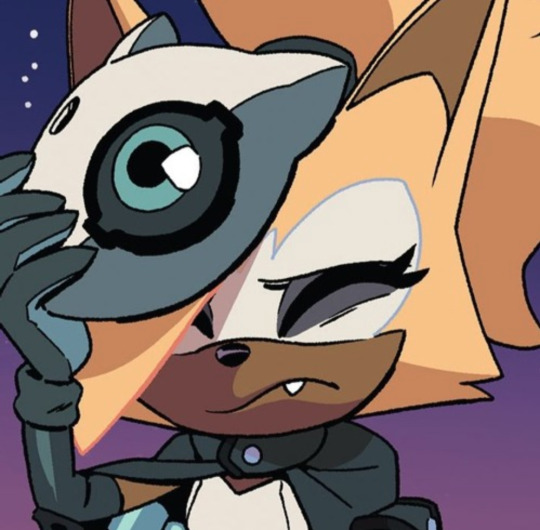
Whisper’s coding is very specific: her mask and her eyes. Whisper’s mask was chosen from a character customization option in Sonic Forces, and was specifically inspired by Japanese Kabuki masks. (Kabuki is a traditional Japanese dance-drama form known for its elaborate costuming, makeup, and masks.)
Whisper’s eyes being almost always closed is partially inspired by traditional depictions of kitsunes with “those iconic squinty-closed eyes.” (See Tails’s section for more kitsune information.) Sega of Japan approved her design as wolves serve the same roles as kitsune in older Japanese folklore.
Vector the Crocodile – Black American
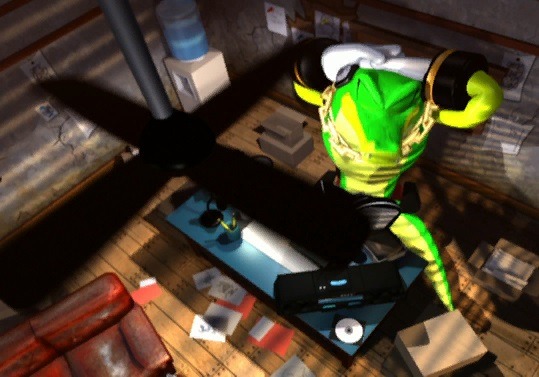
Vector has had quite a bit of black coding over the years, in both positive and negative ways.
Vector is given an appearance shared with/stereotypical of a lot of Black American musicians, particularly in the rapper and hip-hop categories– specifically, his gold chain jewelry, leather clothing, and wireless headphones, esp their positioning in his models. As Vector is a musician, they definitely chose this specific musican-attire for him for a reason. Also, right now, his current English voice actor is Keith Silverstein, a black man.
A lot of Vector’s personality could be read as stereotypical, and at the same time those personality traits could be seen as inverted depending on the source material: he could fall into the “bossy overconfident” stereotype, or that could be seen as subverted due to the fact he is actually competent at his job. He could fall into the “money-hungry” and/or “always poor” trope, or this trait could be seen as relatable due to all of us hating landlords and rent with a passion. He could be “will do anything for money” or he could be presented as someone with strong morals who will always do what is right.
In some media he is seen as hotheaded and aggressive (”Angry Black Man”), while in others he keeps a cool head in times of danger and takes care of his team. You could see him as a “massive flirt” or as just someone who happens to be head-over-heels in love with Vanilla. Hell, his loud music interest could be seen as joking about Black music being “too loud,” or it could be seen as him, you know, just enjoying music!
All this depends on the medium. I don’t feel educated enough on the subject to make a call as to whether he’s a positive or negative stereotype overall, though I think I can say with certainty that Penders’ writing of him in the Archie comics was racist as hell. As @thankskenpenders explained in her article, “Vector was the jive-talking comic relief character. He was obnoxious, he was dim-witted, he was crude, he’d randomly bring up rap music. One time he started singing ‘Dem Bones’ to himself while held captive by the Dark Legion. He was also extremely misogynistic.” Thank God Penders is out...
Master Zik the Zeti – Chinese

Zik’s appearance and characterization are based upon early Chinese poets, who are given a lot of respect in their society, as Zik is given respect among the Zeti.
Zik can definitely fall into the Inscrutable Oriental trope, with his “reserved and stoic” personality. He is also part of the Old Master trope (though he is a villainous rather than heroic character, as is traditional), which tends to intersect with the Magical Asian trope in martial arts stories, most famously in America in The Karate Kid; this inspiration can be seen in most of Zik’s calm dialogue and past as Zavok’s mentor, and the emphasis on his position as a powerful master. His hair is likely a reference to the stereotypical Fu Manchu moustache, and his entrance music is stylized after traditional Chinese music.
Zik also spends his semi-retirement in the garden he tends; this could potentially be a reference to Chinese gardens, which are very important in Chinese literature and philosophy. His game profile also mentions he likes to water his Bonsai tree; while the Bonsai is Japanese, it is derived from traditional Chinese penjing art.
3K notes
·
View notes
Note
🪄 :)
lady of namek - tory lamez!
Can we play with the stars tonight?
Can we make them all align?
So what's it gonna be?
'Cause tonight's the night, so, baby-
[ask game]
1 note
·
View note
Text
this is my masterpost for dear lisa,/torn fabric hello
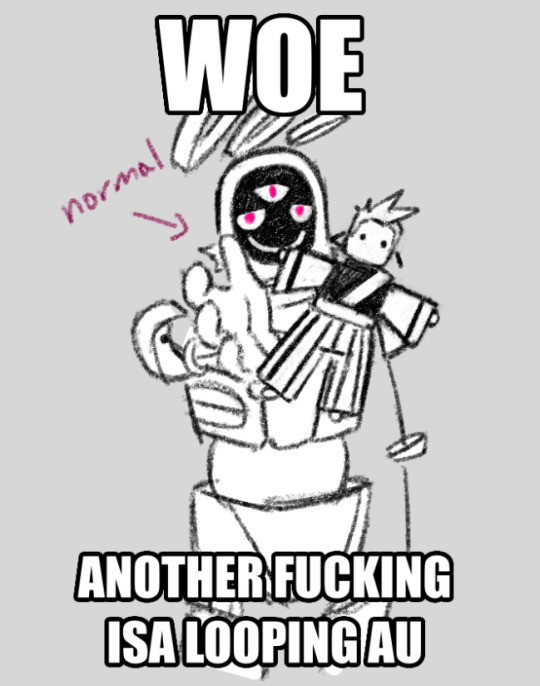
hi welcome to my house of mouse i might as well make a masterpost for this thing. official name for the au is the one i was workshopping:
of tears in fabric
because i got attached! never use temporary names they turn into the actual one. i'm not making a logo because that's not a thing i'm good at. :) i like the imagery of torn fabric. fabric of what? reality, your mind, your flesh, literal fabric, who knows :)! (tear as in rip, btw. i feel like i should note that.)
Maozon - Hullbreaker (original : rework wip : ao3)
Silentroom - Protoflicker (ao3 : chapter 2 solo)
doodle group 1 (3 lisas, 2 freak [disco-descent], 1 siffrin)
ikaruga_nex - ReviXy (Holly's ReviXy is Dead or Alive remix) (inutile : lisa)
act 6 design doodle
postpostgame doodle (and also normal isa wip)
tn-shi - Revelation (post)
lapix - Nothing but Theory (More JazzFunktion Mix) (wip)
family guy death pose
tn-shi - Synthesis. (oracle : dimension/diffraction)
tn-shi - Cyberfantasia (not yet! [wink])
D-D-Dice - World's end loneliness (full ver.) (you wish this green shit healed. not yet!)
goober
the ingot
music miscellanea (updates every so often!)
shinji chair
ETIA. - Kissing Lucifer (post)
the universe if it were a computer (wip)
sprite edits (acts 5/6 spoilers)
Maozon - Stasis (post)
enrichment
(i call him lisa because the L is short for looping! i'm funny)
#torn fabric / OTiF#isat#in stars and time#isat au#isat isabeau#isat spoilers#by nature of it being. an au#ns.tiff#fun fact you cant put a slash in the url or else it'll die so if youre manually typing the tag into a browser put %2F in place of the /#ok that's all my thoughts out. enjoy my very normal posting#core.zip#<- because core is there#o ya. it was called dear lisa; for the imagery of writing a letter to yourself!#but actual titles r cool
29 notes
·
View notes